University Nursing Case Study: Ted Williams' Post-Surgery Care
VerifiedAdded on 2022/07/28
|10
|2846
|19
Case Study
AI Summary
This nursing case study focuses on Ted Williams, a patient who underwent bowel resection surgery and has a temporary colostomy. The study explores the psychosocial impacts of the surgery, including depression, anxiety, and changes in lifestyle, as well as potential post-operative complications like pain, constipation, and changes in vital signs. The assignment addresses constipation, detailing its causes and the impact of bowel resection. It then provides five key nursing interventions: assessing stool characteristics, managing the risk of impaired skin integrity, addressing imbalanced nutrition, managing severe pain, and mitigating the risk of fluid volume deficit. Finally, it discusses pain management strategies using analgesics and interventions to address constipation, including the use of macrogols.
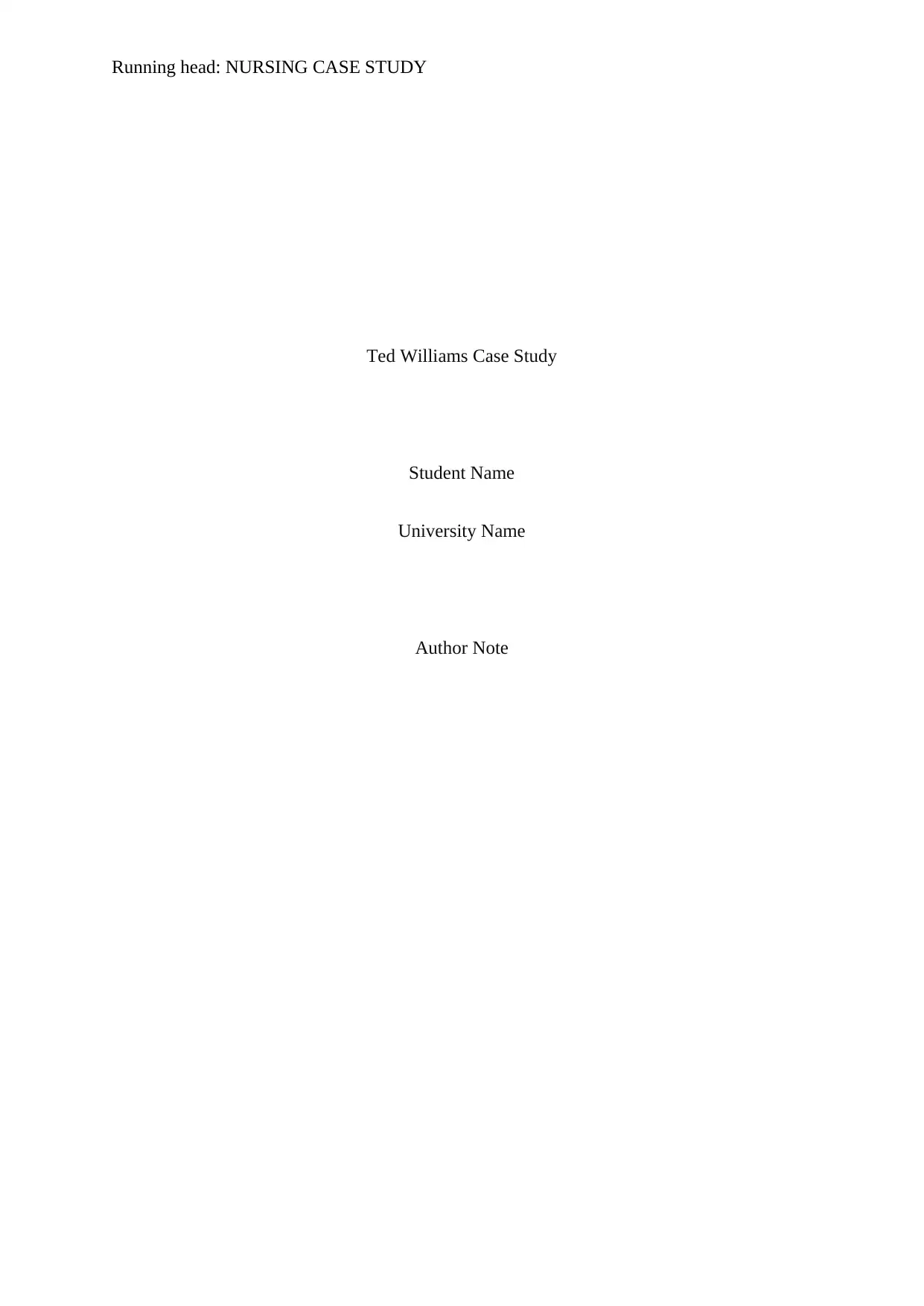
Running head: NURSING CASE STUDY
Ted Williams Case Study
Student Name
University Name
Author Note
Ted Williams Case Study
Student Name
University Name
Author Note
Paraphrase This Document
Need a fresh take? Get an instant paraphrase of this document with our AI Paraphraser
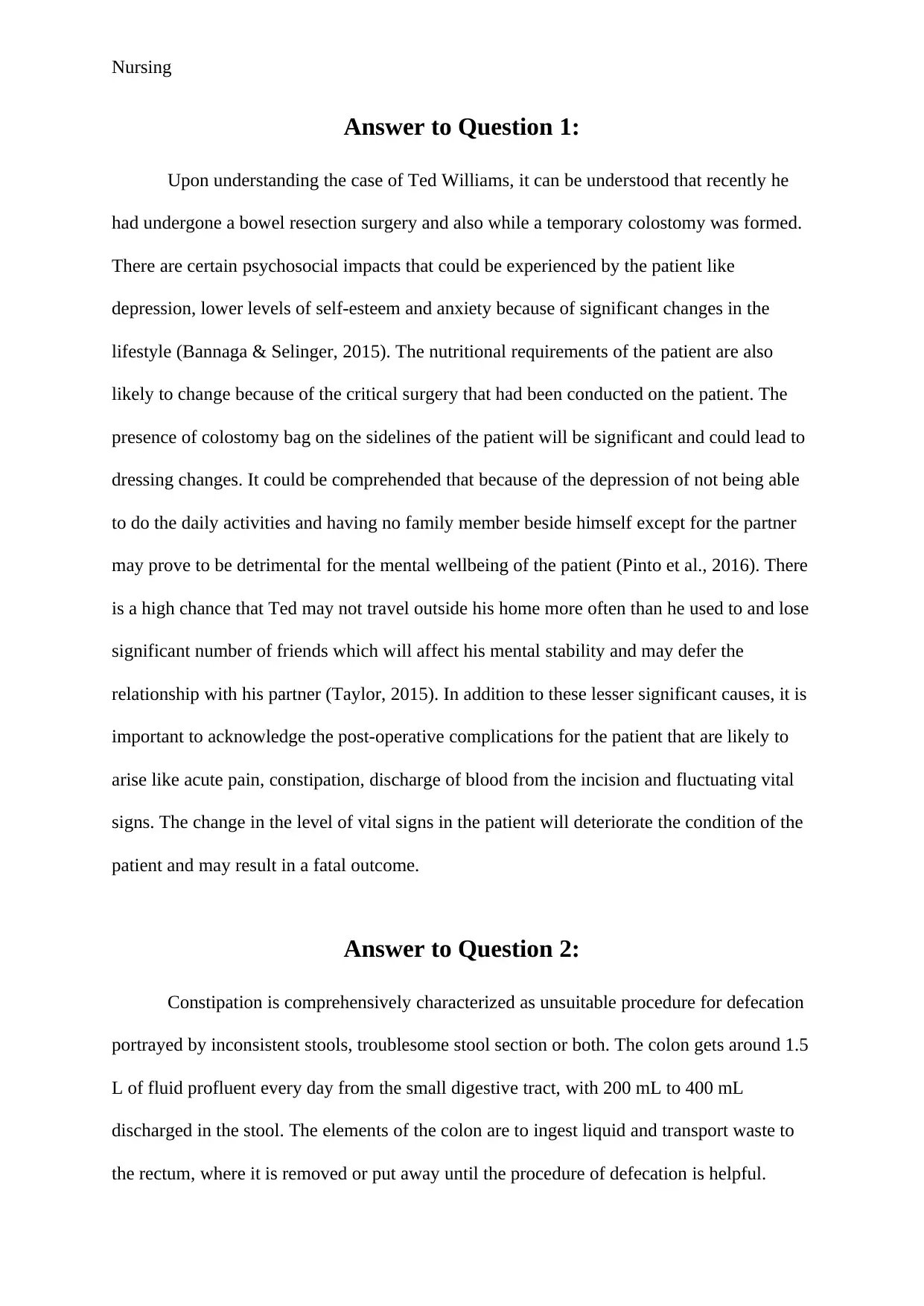
Nursing
Answer to Question 1:
Upon understanding the case of Ted Williams, it can be understood that recently he
had undergone a bowel resection surgery and also while a temporary colostomy was formed.
There are certain psychosocial impacts that could be experienced by the patient like
depression, lower levels of self-esteem and anxiety because of significant changes in the
lifestyle (Bannaga & Selinger, 2015). The nutritional requirements of the patient are also
likely to change because of the critical surgery that had been conducted on the patient. The
presence of colostomy bag on the sidelines of the patient will be significant and could lead to
dressing changes. It could be comprehended that because of the depression of not being able
to do the daily activities and having no family member beside himself except for the partner
may prove to be detrimental for the mental wellbeing of the patient (Pinto et al., 2016). There
is a high chance that Ted may not travel outside his home more often than he used to and lose
significant number of friends which will affect his mental stability and may defer the
relationship with his partner (Taylor, 2015). In addition to these lesser significant causes, it is
important to acknowledge the post-operative complications for the patient that are likely to
arise like acute pain, constipation, discharge of blood from the incision and fluctuating vital
signs. The change in the level of vital signs in the patient will deteriorate the condition of the
patient and may result in a fatal outcome.
Answer to Question 2:
Constipation is comprehensively characterized as unsuitable procedure for defecation
portrayed by inconsistent stools, troublesome stool section or both. The colon gets around 1.5
L of fluid profluent every day from the small digestive tract, with 200 mL to 400 mL
discharged in the stool. The elements of the colon are to ingest liquid and transport waste to
the rectum, where it is removed or put away until the procedure of defecation is helpful.
Answer to Question 1:
Upon understanding the case of Ted Williams, it can be understood that recently he
had undergone a bowel resection surgery and also while a temporary colostomy was formed.
There are certain psychosocial impacts that could be experienced by the patient like
depression, lower levels of self-esteem and anxiety because of significant changes in the
lifestyle (Bannaga & Selinger, 2015). The nutritional requirements of the patient are also
likely to change because of the critical surgery that had been conducted on the patient. The
presence of colostomy bag on the sidelines of the patient will be significant and could lead to
dressing changes. It could be comprehended that because of the depression of not being able
to do the daily activities and having no family member beside himself except for the partner
may prove to be detrimental for the mental wellbeing of the patient (Pinto et al., 2016). There
is a high chance that Ted may not travel outside his home more often than he used to and lose
significant number of friends which will affect his mental stability and may defer the
relationship with his partner (Taylor, 2015). In addition to these lesser significant causes, it is
important to acknowledge the post-operative complications for the patient that are likely to
arise like acute pain, constipation, discharge of blood from the incision and fluctuating vital
signs. The change in the level of vital signs in the patient will deteriorate the condition of the
patient and may result in a fatal outcome.
Answer to Question 2:
Constipation is comprehensively characterized as unsuitable procedure for defecation
portrayed by inconsistent stools, troublesome stool section or both. The colon gets around 1.5
L of fluid profluent every day from the small digestive tract, with 200 mL to 400 mL
discharged in the stool. The elements of the colon are to ingest liquid and transport waste to
the rectum, where it is removed or put away until the procedure of defecation is helpful.
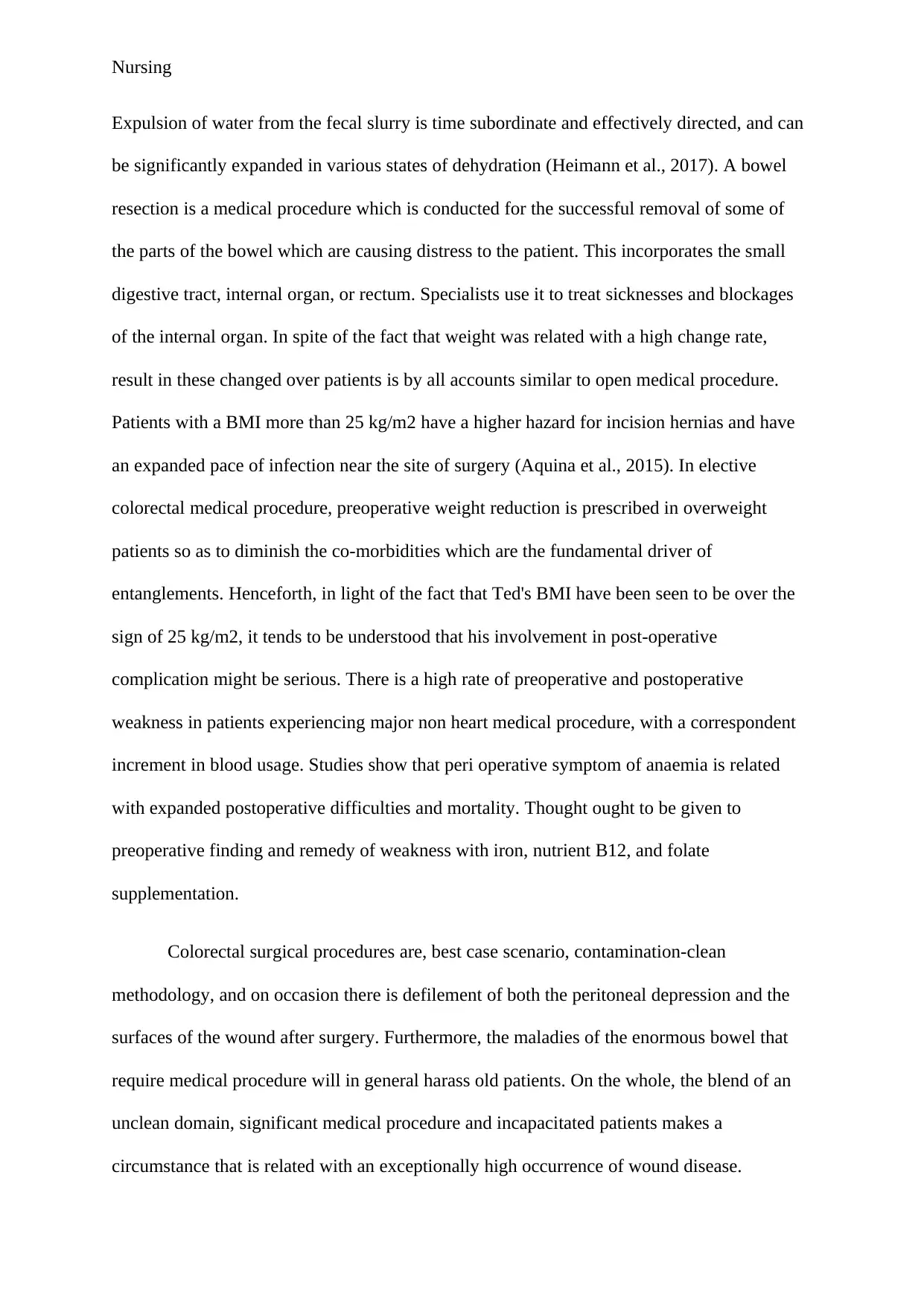
Nursing
Expulsion of water from the fecal slurry is time subordinate and effectively directed, and can
be significantly expanded in various states of dehydration (Heimann et al., 2017). A bowel
resection is a medical procedure which is conducted for the successful removal of some of
the parts of the bowel which are causing distress to the patient. This incorporates the small
digestive tract, internal organ, or rectum. Specialists use it to treat sicknesses and blockages
of the internal organ. In spite of the fact that weight was related with a high change rate,
result in these changed over patients is by all accounts similar to open medical procedure.
Patients with a BMI more than 25 kg/m2 have a higher hazard for incision hernias and have
an expanded pace of infection near the site of surgery (Aquina et al., 2015). In elective
colorectal medical procedure, preoperative weight reduction is prescribed in overweight
patients so as to diminish the co-morbidities which are the fundamental driver of
entanglements. Henceforth, in light of the fact that Ted's BMI have been seen to be over the
sign of 25 kg/m2, it tends to be understood that his involvement in post-operative
complication might be serious. There is a high rate of preoperative and postoperative
weakness in patients experiencing major non heart medical procedure, with a correspondent
increment in blood usage. Studies show that peri operative symptom of anaemia is related
with expanded postoperative difficulties and mortality. Thought ought to be given to
preoperative finding and remedy of weakness with iron, nutrient B12, and folate
supplementation.
Colorectal surgical procedures are, best case scenario, contamination-clean
methodology, and on occasion there is defilement of both the peritoneal depression and the
surfaces of the wound after surgery. Furthermore, the maladies of the enormous bowel that
require medical procedure will in general harass old patients. On the whole, the blend of an
unclean domain, significant medical procedure and incapacitated patients makes a
circumstance that is related with an exceptionally high occurrence of wound disease.
Expulsion of water from the fecal slurry is time subordinate and effectively directed, and can
be significantly expanded in various states of dehydration (Heimann et al., 2017). A bowel
resection is a medical procedure which is conducted for the successful removal of some of
the parts of the bowel which are causing distress to the patient. This incorporates the small
digestive tract, internal organ, or rectum. Specialists use it to treat sicknesses and blockages
of the internal organ. In spite of the fact that weight was related with a high change rate,
result in these changed over patients is by all accounts similar to open medical procedure.
Patients with a BMI more than 25 kg/m2 have a higher hazard for incision hernias and have
an expanded pace of infection near the site of surgery (Aquina et al., 2015). In elective
colorectal medical procedure, preoperative weight reduction is prescribed in overweight
patients so as to diminish the co-morbidities which are the fundamental driver of
entanglements. Henceforth, in light of the fact that Ted's BMI have been seen to be over the
sign of 25 kg/m2, it tends to be understood that his involvement in post-operative
complication might be serious. There is a high rate of preoperative and postoperative
weakness in patients experiencing major non heart medical procedure, with a correspondent
increment in blood usage. Studies show that peri operative symptom of anaemia is related
with expanded postoperative difficulties and mortality. Thought ought to be given to
preoperative finding and remedy of weakness with iron, nutrient B12, and folate
supplementation.
Colorectal surgical procedures are, best case scenario, contamination-clean
methodology, and on occasion there is defilement of both the peritoneal depression and the
surfaces of the wound after surgery. Furthermore, the maladies of the enormous bowel that
require medical procedure will in general harass old patients. On the whole, the blend of an
unclean domain, significant medical procedure and incapacitated patients makes a
circumstance that is related with an exceptionally high occurrence of wound disease.
⊘ This is a preview!⊘
Do you want full access?
Subscribe today to unlock all pages.

Trusted by 1+ million students worldwide
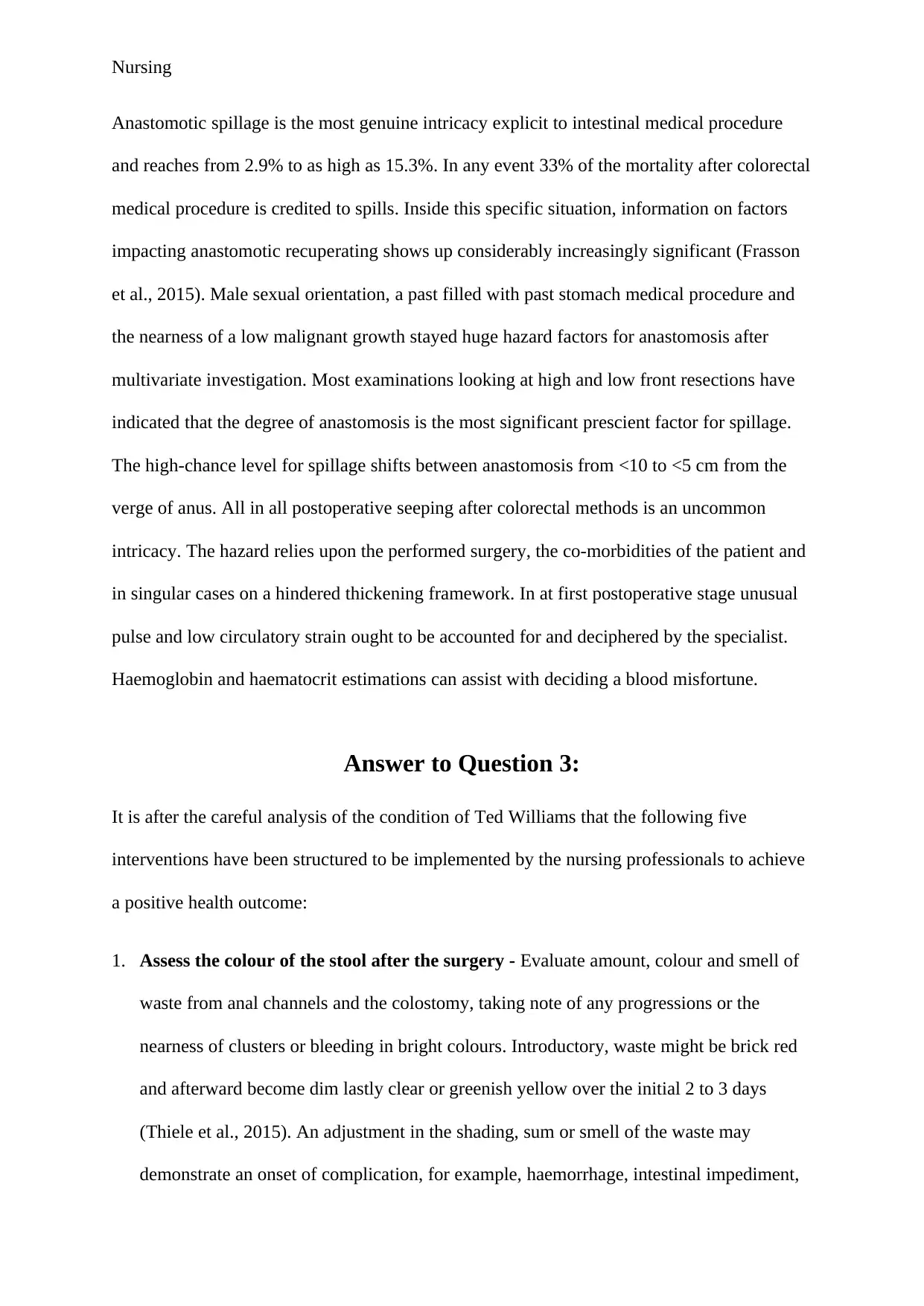
Nursing
Anastomotic spillage is the most genuine intricacy explicit to intestinal medical procedure
and reaches from 2.9% to as high as 15.3%. In any event 33% of the mortality after colorectal
medical procedure is credited to spills. Inside this specific situation, information on factors
impacting anastomotic recuperating shows up considerably increasingly significant (Frasson
et al., 2015). Male sexual orientation, a past filled with past stomach medical procedure and
the nearness of a low malignant growth stayed huge hazard factors for anastomosis after
multivariate investigation. Most examinations looking at high and low front resections have
indicated that the degree of anastomosis is the most significant prescient factor for spillage.
The high-chance level for spillage shifts between anastomosis from <10 to <5 cm from the
verge of anus. All in all postoperative seeping after colorectal methods is an uncommon
intricacy. The hazard relies upon the performed surgery, the co-morbidities of the patient and
in singular cases on a hindered thickening framework. In at first postoperative stage unusual
pulse and low circulatory strain ought to be accounted for and deciphered by the specialist.
Haemoglobin and haematocrit estimations can assist with deciding a blood misfortune.
Answer to Question 3:
It is after the careful analysis of the condition of Ted Williams that the following five
interventions have been structured to be implemented by the nursing professionals to achieve
a positive health outcome:
1. Assess the colour of the stool after the surgery - Evaluate amount, colour and smell of
waste from anal channels and the colostomy, taking note of any progressions or the
nearness of clusters or bleeding in bright colours. Introductory, waste might be brick red
and afterward become dim lastly clear or greenish yellow over the initial 2 to 3 days
(Thiele et al., 2015). An adjustment in the shading, sum or smell of the waste may
demonstrate an onset of complication, for example, haemorrhage, intestinal impediment,
Anastomotic spillage is the most genuine intricacy explicit to intestinal medical procedure
and reaches from 2.9% to as high as 15.3%. In any event 33% of the mortality after colorectal
medical procedure is credited to spills. Inside this specific situation, information on factors
impacting anastomotic recuperating shows up considerably increasingly significant (Frasson
et al., 2015). Male sexual orientation, a past filled with past stomach medical procedure and
the nearness of a low malignant growth stayed huge hazard factors for anastomosis after
multivariate investigation. Most examinations looking at high and low front resections have
indicated that the degree of anastomosis is the most significant prescient factor for spillage.
The high-chance level for spillage shifts between anastomosis from <10 to <5 cm from the
verge of anus. All in all postoperative seeping after colorectal methods is an uncommon
intricacy. The hazard relies upon the performed surgery, the co-morbidities of the patient and
in singular cases on a hindered thickening framework. In at first postoperative stage unusual
pulse and low circulatory strain ought to be accounted for and deciphered by the specialist.
Haemoglobin and haematocrit estimations can assist with deciding a blood misfortune.
Answer to Question 3:
It is after the careful analysis of the condition of Ted Williams that the following five
interventions have been structured to be implemented by the nursing professionals to achieve
a positive health outcome:
1. Assess the colour of the stool after the surgery - Evaluate amount, colour and smell of
waste from anal channels and the colostomy, taking note of any progressions or the
nearness of clusters or bleeding in bright colours. Introductory, waste might be brick red
and afterward become dim lastly clear or greenish yellow over the initial 2 to 3 days
(Thiele et al., 2015). An adjustment in the shading, sum or smell of the waste may
demonstrate an onset of complication, for example, haemorrhage, intestinal impediment,
Paraphrase This Document
Need a fresh take? Get an instant paraphrase of this document with our AI Paraphraser

Nursing
or a possible infection. For certain patients, the indications can improve after some time,
and different patients think that it’s hard to treat and leave a changeless colostomy.
Depending upon the intensity of the condition of the patient, it can be comprehended that
there may be a risk of infection or sepsis which may lead to a bloody discharge. Hence, it
is required for the nursing professionals to check the quality of the stool that is being
discharged by the patient.
2. Risk of impaired skin integrity – Assessing stoma and peristomal skin territory with the
change of each pouch. Note bothering in the form of irritation, wounds and rashes.
Measure stoma occasionally: in any event week after week for initial 6 weeks, at that
point once per month for 6 months. Measure both width and length of stoma (Steinhagen
et al., 2017). As postoperative oedema settle (during initial 6 weeks), the stoma is
observed to shrink and the size of the machine must be changed to guarantee appropriate
fit such that the waste discharge is gathered as it streams from the ostomy and contact
with the skin is forestalled (Kim et al., 2017). Early distinguishing proof of stomal rot or
ischemia or contagious contamination accommodates auspicious mediations to forestall
genuine difficulties. Stoma ought to be red and damp.
3. Risk of imbalanced nutrition – Recognize nourishments which could cause bad-odour
(e.g., beans, fish, cabbage, cauliflower and so on) and incidentally limit from the eating
routine. Bit by bit reintroduce each of the nourishment in turn to the patient. Affectability
to specific nourishments is not extraordinary after intestinal medical procedure (Merritt et
al., 2017). Patient can try different things with nourishment a few times before deciding if
it is making an issue. Prescribe understanding increment utilization of buttermilk,
acidophilus arrangements and yogurt. It might help forestall gas and reduction of odour
development. Resume strong nourishments gradually. Lessens the occurrence of stomach
cramps, queasiness (Winkler & Smith, 2015).
or a possible infection. For certain patients, the indications can improve after some time,
and different patients think that it’s hard to treat and leave a changeless colostomy.
Depending upon the intensity of the condition of the patient, it can be comprehended that
there may be a risk of infection or sepsis which may lead to a bloody discharge. Hence, it
is required for the nursing professionals to check the quality of the stool that is being
discharged by the patient.
2. Risk of impaired skin integrity – Assessing stoma and peristomal skin territory with the
change of each pouch. Note bothering in the form of irritation, wounds and rashes.
Measure stoma occasionally: in any event week after week for initial 6 weeks, at that
point once per month for 6 months. Measure both width and length of stoma (Steinhagen
et al., 2017). As postoperative oedema settle (during initial 6 weeks), the stoma is
observed to shrink and the size of the machine must be changed to guarantee appropriate
fit such that the waste discharge is gathered as it streams from the ostomy and contact
with the skin is forestalled (Kim et al., 2017). Early distinguishing proof of stomal rot or
ischemia or contagious contamination accommodates auspicious mediations to forestall
genuine difficulties. Stoma ought to be red and damp.
3. Risk of imbalanced nutrition – Recognize nourishments which could cause bad-odour
(e.g., beans, fish, cabbage, cauliflower and so on) and incidentally limit from the eating
routine. Bit by bit reintroduce each of the nourishment in turn to the patient. Affectability
to specific nourishments is not extraordinary after intestinal medical procedure (Merritt et
al., 2017). Patient can try different things with nourishment a few times before deciding if
it is making an issue. Prescribe understanding increment utilization of buttermilk,
acidophilus arrangements and yogurt. It might help forestall gas and reduction of odour
development. Resume strong nourishments gradually. Lessens the occurrence of stomach
cramps, queasiness (Winkler & Smith, 2015).
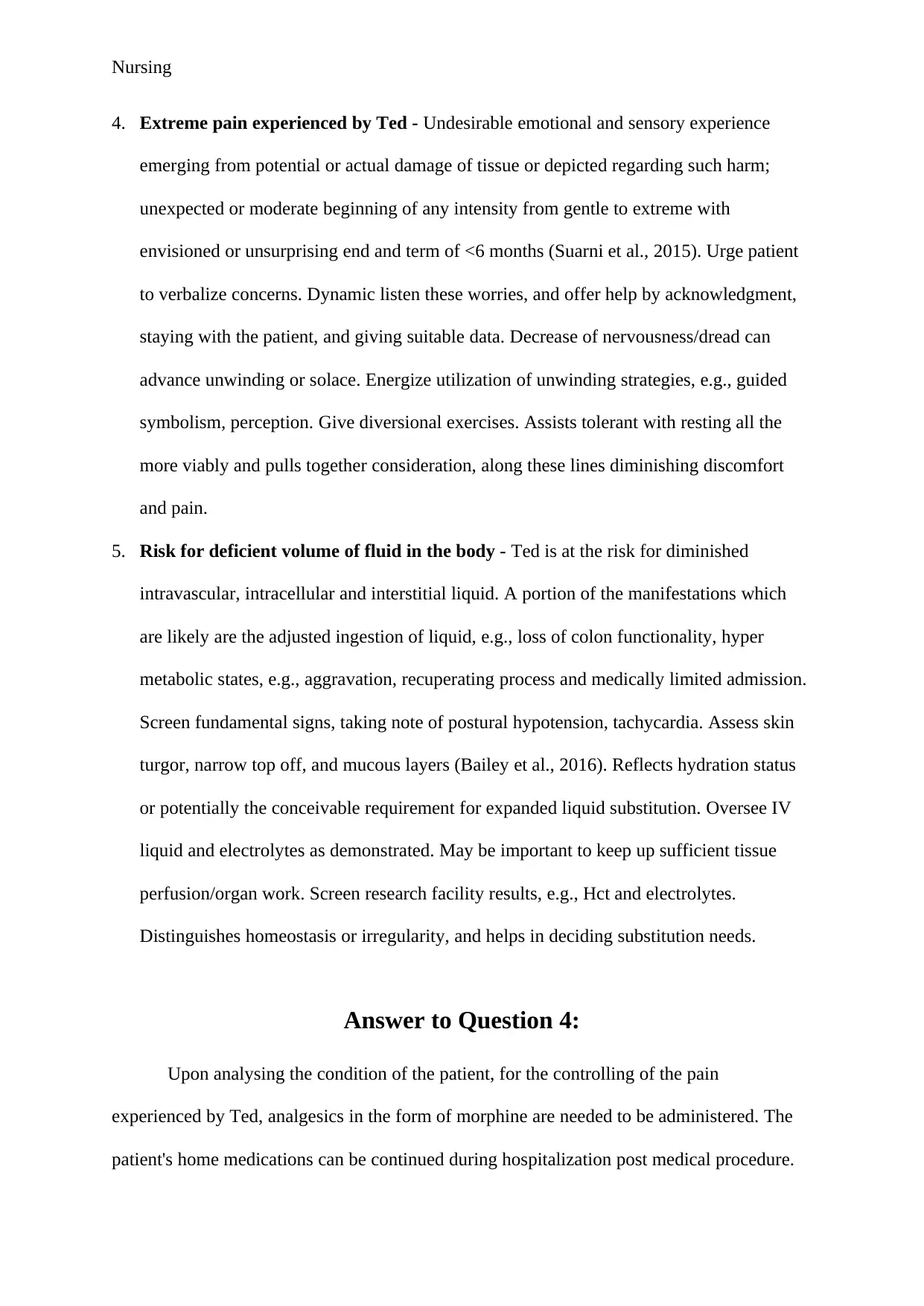
Nursing
4. Extreme pain experienced by Ted - Undesirable emotional and sensory experience
emerging from potential or actual damage of tissue or depicted regarding such harm;
unexpected or moderate beginning of any intensity from gentle to extreme with
envisioned or unsurprising end and term of <6 months (Suarni et al., 2015). Urge patient
to verbalize concerns. Dynamic listen these worries, and offer help by acknowledgment,
staying with the patient, and giving suitable data. Decrease of nervousness/dread can
advance unwinding or solace. Energize utilization of unwinding strategies, e.g., guided
symbolism, perception. Give diversional exercises. Assists tolerant with resting all the
more viably and pulls together consideration, along these lines diminishing discomfort
and pain.
5. Risk for deficient volume of fluid in the body - Ted is at the risk for diminished
intravascular, intracellular and interstitial liquid. A portion of the manifestations which
are likely are the adjusted ingestion of liquid, e.g., loss of colon functionality, hyper
metabolic states, e.g., aggravation, recuperating process and medically limited admission.
Screen fundamental signs, taking note of postural hypotension, tachycardia. Assess skin
turgor, narrow top off, and mucous layers (Bailey et al., 2016). Reflects hydration status
or potentially the conceivable requirement for expanded liquid substitution. Oversee IV
liquid and electrolytes as demonstrated. May be important to keep up sufficient tissue
perfusion/organ work. Screen research facility results, e.g., Hct and electrolytes.
Distinguishes homeostasis or irregularity, and helps in deciding substitution needs.
Answer to Question 4:
Upon analysing the condition of the patient, for the controlling of the pain
experienced by Ted, analgesics in the form of morphine are needed to be administered. The
patient's home medications can be continued during hospitalization post medical procedure.
4. Extreme pain experienced by Ted - Undesirable emotional and sensory experience
emerging from potential or actual damage of tissue or depicted regarding such harm;
unexpected or moderate beginning of any intensity from gentle to extreme with
envisioned or unsurprising end and term of <6 months (Suarni et al., 2015). Urge patient
to verbalize concerns. Dynamic listen these worries, and offer help by acknowledgment,
staying with the patient, and giving suitable data. Decrease of nervousness/dread can
advance unwinding or solace. Energize utilization of unwinding strategies, e.g., guided
symbolism, perception. Give diversional exercises. Assists tolerant with resting all the
more viably and pulls together consideration, along these lines diminishing discomfort
and pain.
5. Risk for deficient volume of fluid in the body - Ted is at the risk for diminished
intravascular, intracellular and interstitial liquid. A portion of the manifestations which
are likely are the adjusted ingestion of liquid, e.g., loss of colon functionality, hyper
metabolic states, e.g., aggravation, recuperating process and medically limited admission.
Screen fundamental signs, taking note of postural hypotension, tachycardia. Assess skin
turgor, narrow top off, and mucous layers (Bailey et al., 2016). Reflects hydration status
or potentially the conceivable requirement for expanded liquid substitution. Oversee IV
liquid and electrolytes as demonstrated. May be important to keep up sufficient tissue
perfusion/organ work. Screen research facility results, e.g., Hct and electrolytes.
Distinguishes homeostasis or irregularity, and helps in deciding substitution needs.
Answer to Question 4:
Upon analysing the condition of the patient, for the controlling of the pain
experienced by Ted, analgesics in the form of morphine are needed to be administered. The
patient's home medications can be continued during hospitalization post medical procedure.
⊘ This is a preview!⊘
Do you want full access?
Subscribe today to unlock all pages.

Trusted by 1+ million students worldwide
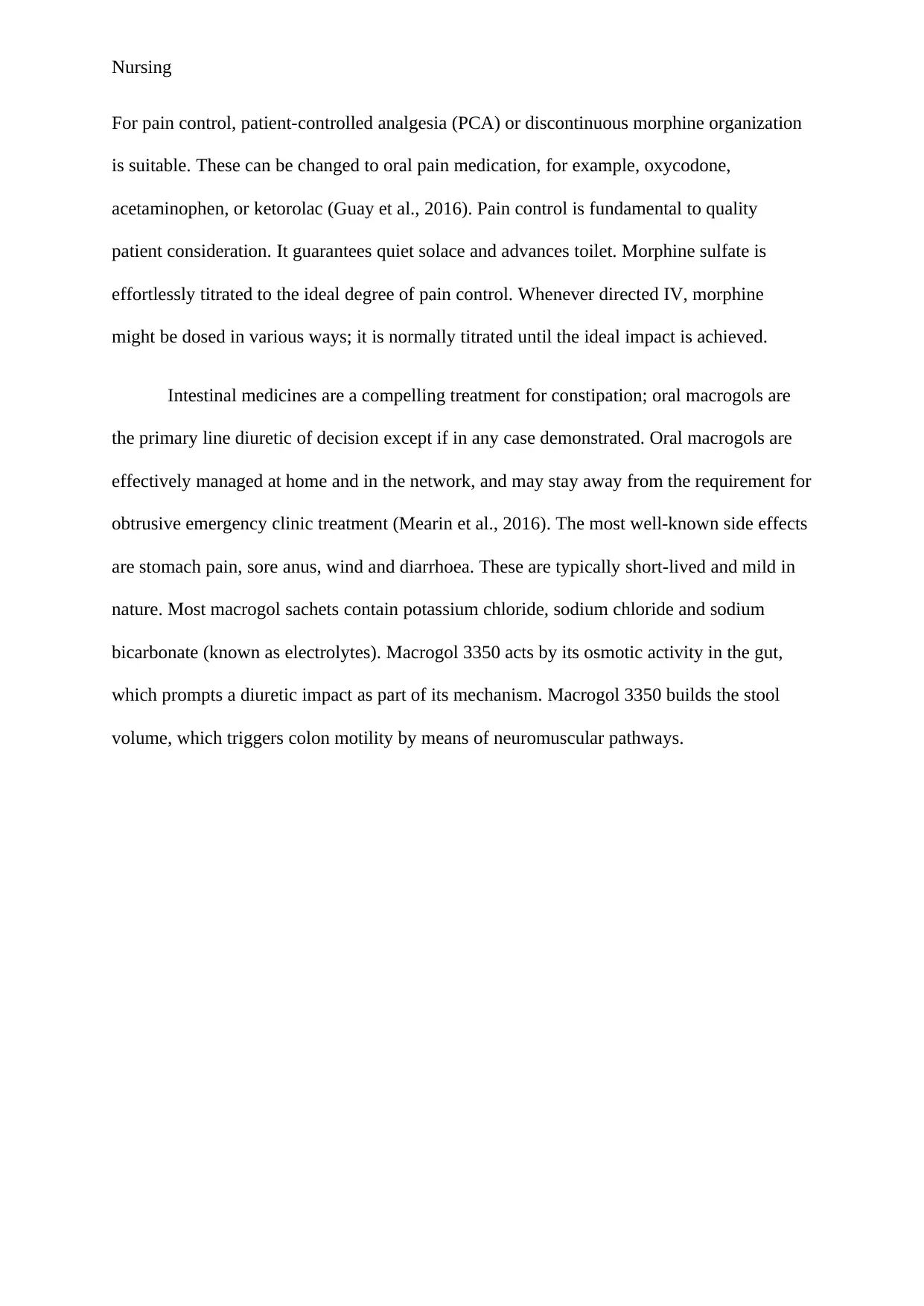
Nursing
For pain control, patient-controlled analgesia (PCA) or discontinuous morphine organization
is suitable. These can be changed to oral pain medication, for example, oxycodone,
acetaminophen, or ketorolac (Guay et al., 2016). Pain control is fundamental to quality
patient consideration. It guarantees quiet solace and advances toilet. Morphine sulfate is
effortlessly titrated to the ideal degree of pain control. Whenever directed IV, morphine
might be dosed in various ways; it is normally titrated until the ideal impact is achieved.
Intestinal medicines are a compelling treatment for constipation; oral macrogols are
the primary line diuretic of decision except if in any case demonstrated. Oral macrogols are
effectively managed at home and in the network, and may stay away from the requirement for
obtrusive emergency clinic treatment (Mearin et al., 2016). The most well-known side effects
are stomach pain, sore anus, wind and diarrhoea. These are typically short-lived and mild in
nature. Most macrogol sachets contain potassium chloride, sodium chloride and sodium
bicarbonate (known as electrolytes). Macrogol 3350 acts by its osmotic activity in the gut,
which prompts a diuretic impact as part of its mechanism. Macrogol 3350 builds the stool
volume, which triggers colon motility by means of neuromuscular pathways.
For pain control, patient-controlled analgesia (PCA) or discontinuous morphine organization
is suitable. These can be changed to oral pain medication, for example, oxycodone,
acetaminophen, or ketorolac (Guay et al., 2016). Pain control is fundamental to quality
patient consideration. It guarantees quiet solace and advances toilet. Morphine sulfate is
effortlessly titrated to the ideal degree of pain control. Whenever directed IV, morphine
might be dosed in various ways; it is normally titrated until the ideal impact is achieved.
Intestinal medicines are a compelling treatment for constipation; oral macrogols are
the primary line diuretic of decision except if in any case demonstrated. Oral macrogols are
effectively managed at home and in the network, and may stay away from the requirement for
obtrusive emergency clinic treatment (Mearin et al., 2016). The most well-known side effects
are stomach pain, sore anus, wind and diarrhoea. These are typically short-lived and mild in
nature. Most macrogol sachets contain potassium chloride, sodium chloride and sodium
bicarbonate (known as electrolytes). Macrogol 3350 acts by its osmotic activity in the gut,
which prompts a diuretic impact as part of its mechanism. Macrogol 3350 builds the stool
volume, which triggers colon motility by means of neuromuscular pathways.
Paraphrase This Document
Need a fresh take? Get an instant paraphrase of this document with our AI Paraphraser
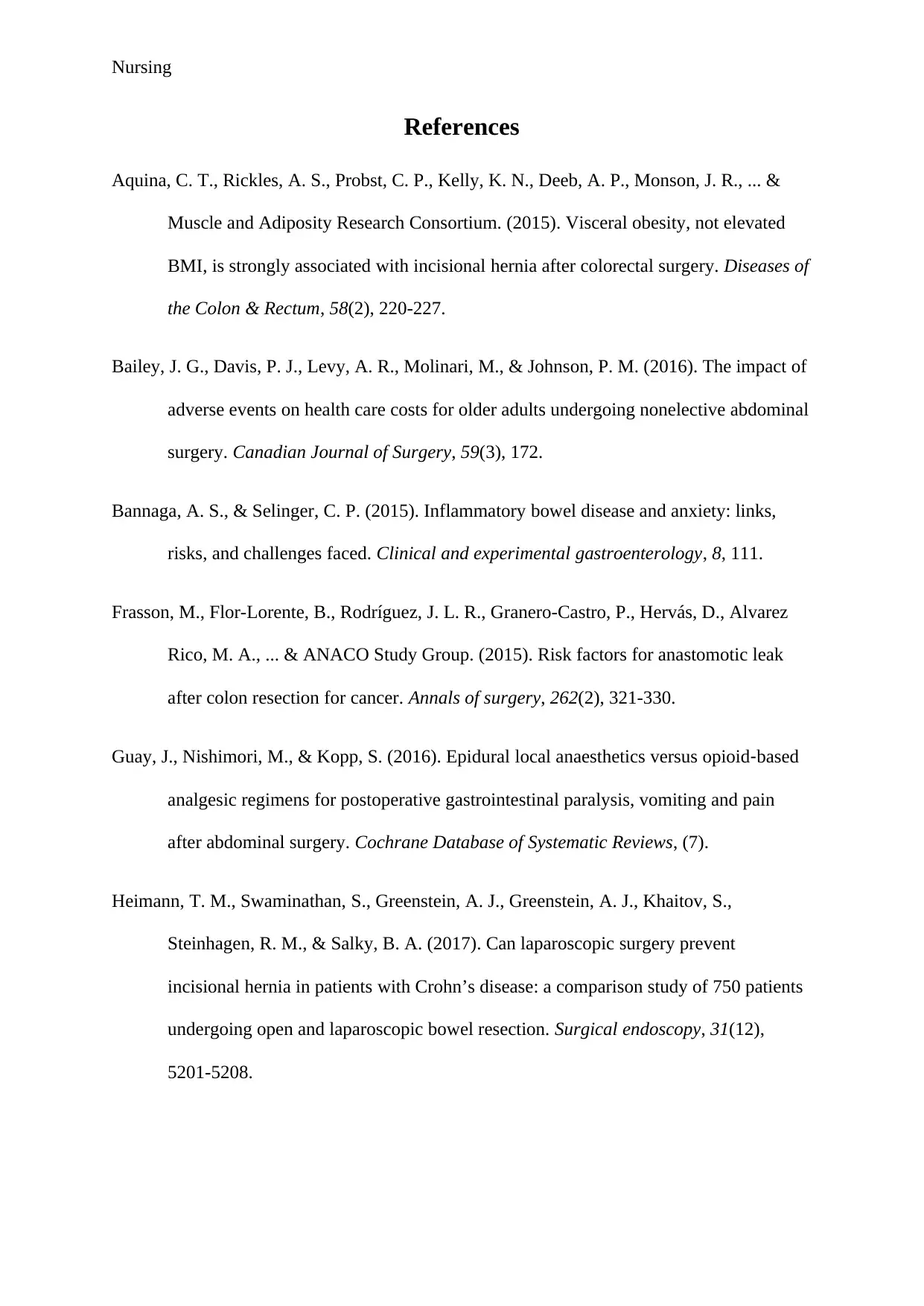
Nursing
References
Aquina, C. T., Rickles, A. S., Probst, C. P., Kelly, K. N., Deeb, A. P., Monson, J. R., ... &
Muscle and Adiposity Research Consortium. (2015). Visceral obesity, not elevated
BMI, is strongly associated with incisional hernia after colorectal surgery. Diseases of
the Colon & Rectum, 58(2), 220-227.
Bailey, J. G., Davis, P. J., Levy, A. R., Molinari, M., & Johnson, P. M. (2016). The impact of
adverse events on health care costs for older adults undergoing nonelective abdominal
surgery. Canadian Journal of Surgery, 59(3), 172.
Bannaga, A. S., & Selinger, C. P. (2015). Inflammatory bowel disease and anxiety: links,
risks, and challenges faced. Clinical and experimental gastroenterology, 8, 111.
Frasson, M., Flor-Lorente, B., Rodríguez, J. L. R., Granero-Castro, P., Hervás, D., Alvarez
Rico, M. A., ... & ANACO Study Group. (2015). Risk factors for anastomotic leak
after colon resection for cancer. Annals of surgery, 262(2), 321-330.
Guay, J., Nishimori, M., & Kopp, S. (2016). Epidural local anaesthetics versus opioid‐based
analgesic regimens for postoperative gastrointestinal paralysis, vomiting and pain
after abdominal surgery. Cochrane Database of Systematic Reviews, (7).
Heimann, T. M., Swaminathan, S., Greenstein, A. J., Greenstein, A. J., Khaitov, S.,
Steinhagen, R. M., & Salky, B. A. (2017). Can laparoscopic surgery prevent
incisional hernia in patients with Crohn’s disease: a comparison study of 750 patients
undergoing open and laparoscopic bowel resection. Surgical endoscopy, 31(12),
5201-5208.
References
Aquina, C. T., Rickles, A. S., Probst, C. P., Kelly, K. N., Deeb, A. P., Monson, J. R., ... &
Muscle and Adiposity Research Consortium. (2015). Visceral obesity, not elevated
BMI, is strongly associated with incisional hernia after colorectal surgery. Diseases of
the Colon & Rectum, 58(2), 220-227.
Bailey, J. G., Davis, P. J., Levy, A. R., Molinari, M., & Johnson, P. M. (2016). The impact of
adverse events on health care costs for older adults undergoing nonelective abdominal
surgery. Canadian Journal of Surgery, 59(3), 172.
Bannaga, A. S., & Selinger, C. P. (2015). Inflammatory bowel disease and anxiety: links,
risks, and challenges faced. Clinical and experimental gastroenterology, 8, 111.
Frasson, M., Flor-Lorente, B., Rodríguez, J. L. R., Granero-Castro, P., Hervás, D., Alvarez
Rico, M. A., ... & ANACO Study Group. (2015). Risk factors for anastomotic leak
after colon resection for cancer. Annals of surgery, 262(2), 321-330.
Guay, J., Nishimori, M., & Kopp, S. (2016). Epidural local anaesthetics versus opioid‐based
analgesic regimens for postoperative gastrointestinal paralysis, vomiting and pain
after abdominal surgery. Cochrane Database of Systematic Reviews, (7).
Heimann, T. M., Swaminathan, S., Greenstein, A. J., Greenstein, A. J., Khaitov, S.,
Steinhagen, R. M., & Salky, B. A. (2017). Can laparoscopic surgery prevent
incisional hernia in patients with Crohn’s disease: a comparison study of 750 patients
undergoing open and laparoscopic bowel resection. Surgical endoscopy, 31(12),
5201-5208.
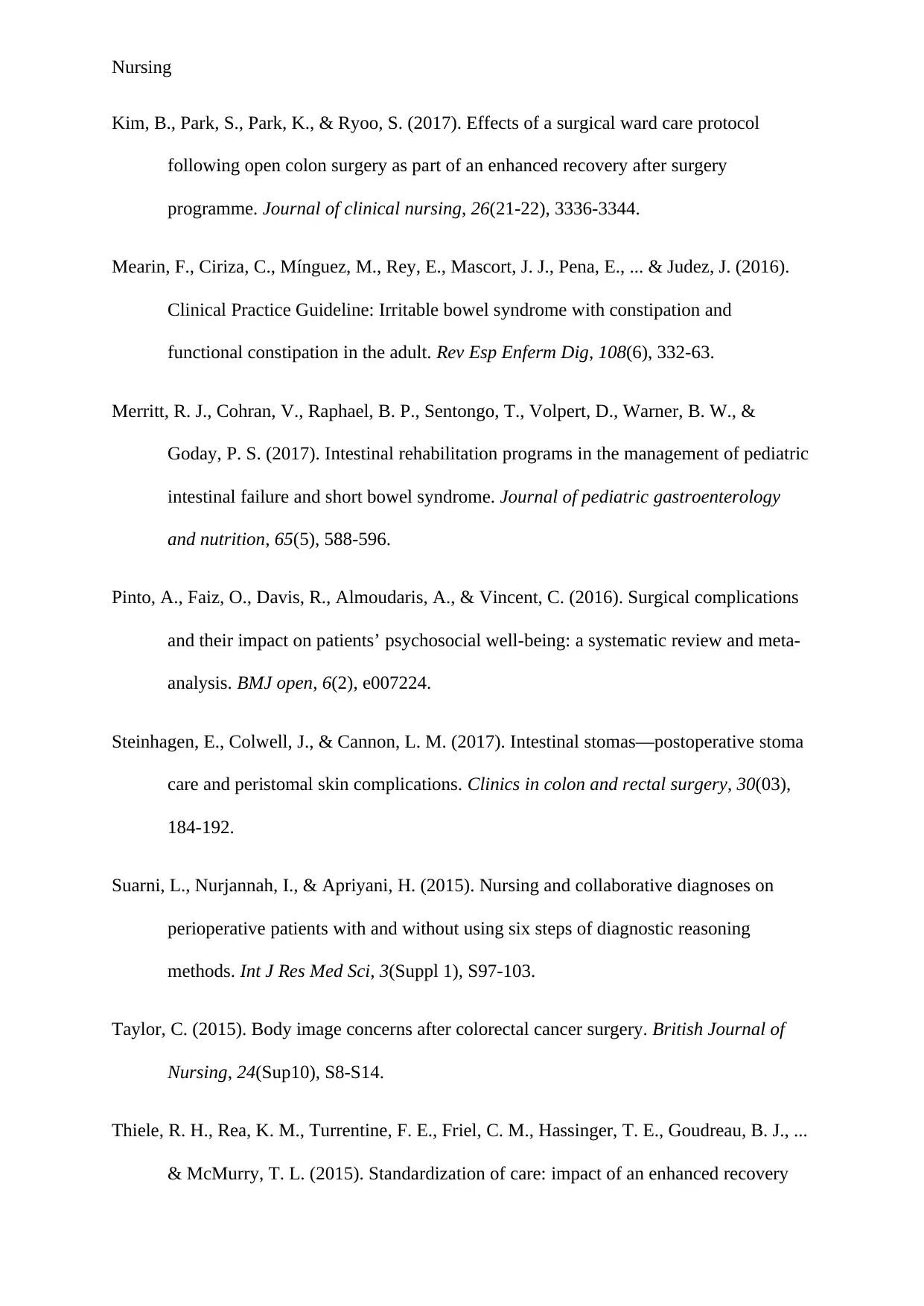
Nursing
Kim, B., Park, S., Park, K., & Ryoo, S. (2017). Effects of a surgical ward care protocol
following open colon surgery as part of an enhanced recovery after surgery
programme. Journal of clinical nursing, 26(21-22), 3336-3344.
Mearin, F., Ciriza, C., Mínguez, M., Rey, E., Mascort, J. J., Pena, E., ... & Judez, J. (2016).
Clinical Practice Guideline: Irritable bowel syndrome with constipation and
functional constipation in the adult. Rev Esp Enferm Dig, 108(6), 332-63.
Merritt, R. J., Cohran, V., Raphael, B. P., Sentongo, T., Volpert, D., Warner, B. W., &
Goday, P. S. (2017). Intestinal rehabilitation programs in the management of pediatric
intestinal failure and short bowel syndrome. Journal of pediatric gastroenterology
and nutrition, 65(5), 588-596.
Pinto, A., Faiz, O., Davis, R., Almoudaris, A., & Vincent, C. (2016). Surgical complications
and their impact on patients’ psychosocial well-being: a systematic review and meta-
analysis. BMJ open, 6(2), e007224.
Steinhagen, E., Colwell, J., & Cannon, L. M. (2017). Intestinal stomas—postoperative stoma
care and peristomal skin complications. Clinics in colon and rectal surgery, 30(03),
184-192.
Suarni, L., Nurjannah, I., & Apriyani, H. (2015). Nursing and collaborative diagnoses on
perioperative patients with and without using six steps of diagnostic reasoning
methods. Int J Res Med Sci, 3(Suppl 1), S97-103.
Taylor, C. (2015). Body image concerns after colorectal cancer surgery. British Journal of
Nursing, 24(Sup10), S8-S14.
Thiele, R. H., Rea, K. M., Turrentine, F. E., Friel, C. M., Hassinger, T. E., Goudreau, B. J., ...
& McMurry, T. L. (2015). Standardization of care: impact of an enhanced recovery
Kim, B., Park, S., Park, K., & Ryoo, S. (2017). Effects of a surgical ward care protocol
following open colon surgery as part of an enhanced recovery after surgery
programme. Journal of clinical nursing, 26(21-22), 3336-3344.
Mearin, F., Ciriza, C., Mínguez, M., Rey, E., Mascort, J. J., Pena, E., ... & Judez, J. (2016).
Clinical Practice Guideline: Irritable bowel syndrome with constipation and
functional constipation in the adult. Rev Esp Enferm Dig, 108(6), 332-63.
Merritt, R. J., Cohran, V., Raphael, B. P., Sentongo, T., Volpert, D., Warner, B. W., &
Goday, P. S. (2017). Intestinal rehabilitation programs in the management of pediatric
intestinal failure and short bowel syndrome. Journal of pediatric gastroenterology
and nutrition, 65(5), 588-596.
Pinto, A., Faiz, O., Davis, R., Almoudaris, A., & Vincent, C. (2016). Surgical complications
and their impact on patients’ psychosocial well-being: a systematic review and meta-
analysis. BMJ open, 6(2), e007224.
Steinhagen, E., Colwell, J., & Cannon, L. M. (2017). Intestinal stomas—postoperative stoma
care and peristomal skin complications. Clinics in colon and rectal surgery, 30(03),
184-192.
Suarni, L., Nurjannah, I., & Apriyani, H. (2015). Nursing and collaborative diagnoses on
perioperative patients with and without using six steps of diagnostic reasoning
methods. Int J Res Med Sci, 3(Suppl 1), S97-103.
Taylor, C. (2015). Body image concerns after colorectal cancer surgery. British Journal of
Nursing, 24(Sup10), S8-S14.
Thiele, R. H., Rea, K. M., Turrentine, F. E., Friel, C. M., Hassinger, T. E., Goudreau, B. J., ...
& McMurry, T. L. (2015). Standardization of care: impact of an enhanced recovery
⊘ This is a preview!⊘
Do you want full access?
Subscribe today to unlock all pages.

Trusted by 1+ million students worldwide

Nursing
protocol on length of stay, complications, and direct costs after colorectal
surgery. Journal of the American College of Surgeons, 220(4), 430-443.
Winkler, M. F., & Smith, C. E. (2015). The Impact of Long-Term Home Parenteral Nutrition
on the Patient and the Family. Journal of Infusion Nursing, 38(4), 290-300.
protocol on length of stay, complications, and direct costs after colorectal
surgery. Journal of the American College of Surgeons, 220(4), 430-443.
Winkler, M. F., & Smith, C. E. (2015). The Impact of Long-Term Home Parenteral Nutrition
on the Patient and the Family. Journal of Infusion Nursing, 38(4), 290-300.
1 out of 10
Related Documents
Your All-in-One AI-Powered Toolkit for Academic Success.
+13062052269
info@desklib.com
Available 24*7 on WhatsApp / Email
![[object Object]](/_next/static/media/star-bottom.7253800d.svg)
Unlock your academic potential
Copyright © 2020–2025 A2Z Services. All Rights Reserved. Developed and managed by ZUCOL.





